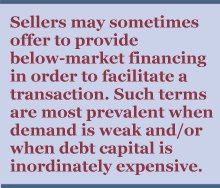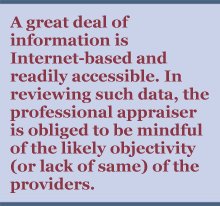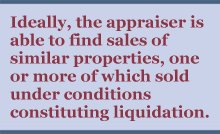

|
207 Abbey Lane Lansdale, Pennsylvania 19446 215-855-1800 |
5201 Ocean Avenue #2007 Wildwood, New Jersey 08260 215-990-6663 |
Specializing in Real Estate Appraisal and Property Tax Consulting
A Professional Courtesy of:
|

Specializing in Real Estate Appraisal and Property Tax Consulting |
| AUTUMN 2008 |
 |
|
In This Issue:
|
|
Market Value in the Absence of Buyers The concept of market value implicitly involves the sale of property. In some cases, there are few, if any, buyers with whom to consummate a sale. In the absence of buyers, how then should market value be estimated?In the literal sense, a property for which there is a complete absence of buyers has no market value; however, such instances are, indeed, rare. A dearth of potential buyers can be attributable either to the specific characteristics of a particular property or to market conditions. The former is likely to be a long-term characteristic; the latter is likely to be of short-or intermediate-term duration. Properties characterized as special or single-purpose properties are those with unique design, layout and/or materials. Such properties are designed for specific uses and users, and may be suitable for a limited number of occupants. Furthermore, such properties are typically difficult, if not impossible, to convert or reconfigure for other uses and users. Examples of such properties are large manufacturing plants, and research and development facilities. In such situations, one must be mindful of the differences between market value and use value. The latter is "the value of a property as it is currently used, not its value considering alternative uses" (The Appraisal of Real Estate, 12th Edition).  The valuation of such limited use properties represents a challenge to the valuation professional. Thorough research, often on a national basis, is required for a sound appraisal. Such valuations typically require that the appraiser gain an understanding of the industry within which users of such properties compete. By so doing, the appraiser gains insight into the property characteristics necessary for such users. In any case, the appraiser's opinion of market value must be predicated on market evidence gleaned from his or her research.
The valuation of such limited use properties represents a challenge to the valuation professional. Thorough research, often on a national basis, is required for a sound appraisal. Such valuations typically require that the appraiser gain an understanding of the industry within which users of such properties compete. By so doing, the appraiser gains insight into the property characteristics necessary for such users. In any case, the appraiser's opinion of market value must be predicated on market evidence gleaned from his or her research.Separately, market conditions may be such that few buyers exist for an otherwise marketable property. In times of severe overbuilding, the truth of the axiom that real estate has value only to the extent that it provides an economic benefit becomes quite apparent. A corollary axiom is that real estate has no intrinsic value (i.e., no economic utility equals no value). Buyers also may be limited due to disruptions in the credit markets that affect the availability and cost of capital. Income-producing real estate is, of course, quite capital-intensive, and such disruptions may have a profound effect upon marketability and price and/or value. In periods of extreme market "softness" with few buyers, some valuation professionals may be tempted to base opinions of market value on forecasts of a return of "normal" market conditions, discounted to the present. Such opinions are highly suspect unless they mirror the actions of potential buyers. These forecasts are obviously imprecise. Furthermore, who can say what "normal" market conditions are? In estimating market value in a "soft" market, the appraiser must utilize available transactions. One cannot simply dismiss such transactions as "distressed" when, indeed, the entire market is distressed. |
Treatment of Concessions and Inducements Most definitions of market value are based on cash or cash equivalent consideration (i.e., unaffected by below-market financing). Similarly, market rent is expressed in terms that are net of "free rent" or inordinately high tenant-improvement allowances.The valuation professional relies on a variety of data in developing opinions of market rent and market value. When such opinions are sought, the data on which the analyses are based must be adjusted to market terms.  Sellers may sometimes offer to provide below-market financing in order to facilitate a transaction. Such terms are most prevalent when demand is weak and/or when debt capital is inordinately expensive. Thus, the appraiser analyzes comparable sales to determine whether such accommodations were made to induce transactions. In order to do so, he or she must be aware of mortgage terms from third-party lenders. If below-market financing was provided, the comparable sales should be adjusted downward.
Sellers may sometimes offer to provide below-market financing in order to facilitate a transaction. Such terms are most prevalent when demand is weak and/or when debt capital is inordinately expensive. Thus, the appraiser analyzes comparable sales to determine whether such accommodations were made to induce transactions. In order to do so, he or she must be aware of mortgage terms from third-party lenders. If below-market financing was provided, the comparable sales should be adjusted downward.These adjustments are often based on the present worth of the difference between market-based and actual debt service, discounted at the market mortgage-interest rate. However, it is quite important for the appraiser to compare transactions involving below-market financing with those at market to determine the reasonableness of these mathematical calculations. If not supported by market evidence, such adjustments are not warranted. Below-market terms may involve low interest rates, higher than normal loan-to-value ratios, interest-only mortgages and/or extended amortization periods. In the sale of condominium units by the developer or converter, inducements are sometimes offered, particularly when demand is weak. Such inducements may take many forms, including the payment of all closing costs, free club memberships, automobiles or vacation trips. Clearly, such inducements must be quantified and deducted from such sales in order to arrive at the market value of the real estate, rather than that of the real estate and the intangible and/or personal property offered as an inducement.  Comparable rental rates require similar analysis. Concessions and inducements often take the form of "free" rent, moving allowances, assumption of existing lease obligations, high tenant improvement allowances, free or reduced rates for parking, reduced or waived deposits, and "most favored nation" clauses. The latter provides the lessee with the right to a lowered rental rate matching that for subsequently leased similar space in the same building at a lesser rate. In apartment leasing, "move-in specials" are sometimes offered, and involve waived application fees and/or reduced rent for a portion or all of the lease term.
Comparable rental rates require similar analysis. Concessions and inducements often take the form of "free" rent, moving allowances, assumption of existing lease obligations, high tenant improvement allowances, free or reduced rates for parking, reduced or waived deposits, and "most favored nation" clauses. The latter provides the lessee with the right to a lowered rental rate matching that for subsequently leased similar space in the same building at a lesser rate. In apartment leasing, "move-in specials" are sometimes offered, and involve waived application fees and/or reduced rent for a portion or all of the lease term.In order to estimate market rent (and hence market value), such comparable data must be carefully analyzed and adjusted to market terms. In all cases, it is the market's reaction to such concessions rather than the appraiser's mathematical formulations that constitute proper treatment of such factors. |
Sources of Market Data Valuation professionals have unprecedented access to a broad spectrum of information on which to base their analyses and opinions. This information generally takes the form of both macro and micro (property-specific) data.Macro data include national and international influences, local and regional factors, and neighborhood and market-area forces affecting real estate. Some of this information deals with factors that impact real estate while the balance relates specifically to real estate, often by property type. Providers of such information are far too numerous to cite but include governmental agencies, business trade groups, investment banks, rating agencies, real estate brokerage firms, lenders, universities and private-sector research firms. Much of these data are available free of charge, with the balance provided by either annual subscription or on a report-by-report basis. A great deal of information is Internet-based and readily accessible. In reviewing such data, the professional appraiser is obliged to be mindful of the likely objectivity (or lack of same) of the providers.  Needed property-specific information includes that relating to zoning, building codes, floodplain location, topography, deed restrictions, utilities, real estate taxes and legal descriptions. Most of this information may be obtained from the appropriate governmental departments or agencies.
Needed property-specific information includes that relating to zoning, building codes, floodplain location, topography, deed restrictions, utilities, real estate taxes and legal descriptions. Most of this information may be obtained from the appropriate governmental departments or agencies.Comparable data (sales, leases, expenses, income and expense growth rates, and yield rates) are obviously of vital importance to the appraiser. Comparable sales are obtainable from fee-based providers, some of which provide sales in many markets throughout the United States. These providers are especially important in so-called nondisclosure states. In such states, sale prices are not disclosed in documents filed for public record. The appraiser's task in gathering sales is clearly easier in those states that do require the disclosure of sale prices. Nevertheless, appraisers should verify sale prices prior to relying on them. Other sources of sales data are media stories, both online and in hard copy, the brokerage community, lenders and other appraisers. Given the power of Internet search engines, the appraiser may learn of transactions throughout most of the United States by entering appropriate keywords. Larger brokerage firms clearly have significant databases of sales transactions. However, such data may be available only to appraisers within the firm, to clients and to cooperating brokerage firms. Lastly, most professional appraisers are willing to exchange sales data with other appraisers.  Lease data are much more difficult to obtain because they are typically not filed in public records. Primary sources of details regarding executed leases are leasing agents, lessors and lessees, building owners and appraisers' own files (prior assignments). In the case of the latter, the appraiser is required to maintain confidentiality where appropriate.
Lease data are much more difficult to obtain because they are typically not filed in public records. Primary sources of details regarding executed leases are leasing agents, lessors and lessees, building owners and appraisers' own files (prior assignments). In the case of the latter, the appraiser is required to maintain confidentiality where appropriate.Expense comparables are also difficult to obtain. There are published industry surveys of expenses by property type. Clients are sometimes helpful in providing such information. Furthermore, appraisers' files contain such data, usable subject to confidentiality requirements. To the extent that a discounted cash flow analysis is used, the appraiser needs market support for estimates of growth in income and expenses. Furthermore, the appraiser needs market support for the appropriate yield (discount) rate. The typical basis for such estimates is published survey information. Such surveys are based on responses of investors and lenders, as well as both property type and location (city or region). |
Liquidation and "Go Dark" Values Liquidation value is "the most probable price that a specified interest in real property is likely to bring under all of the following conditions:

 Note that the time assumed for the marketing period is specified by the client. In practical terms, such periods are usually in the range of 60-90 days.
Note that the time assumed for the marketing period is specified by the client. In practical terms, such periods are usually in the range of 60-90 days.The starting point for arriving at an opinion of liquidation value is the estimation of market value. The next step is to estimate the appropriate degree of discount from market value to induce a sale within the compressed marketing period. Ideally, the appraiser is able to find sales of similar properties, one or more of which sold under conditions constituting liquidation. This is often not possible due to the lack of such data. Alternatively, the appraiser may seek opinions from knowledgeable brokers and investors in the market of the likely discount. Such opinions typically reflect a discount in the range of 15-20%. There is not an authoritative definition of "go dark" value. Simply put, it is the market value of a property assuming lease termination of the primary tenant. This value opinion is usually requested by a lender when underwriting a mortgage loan on a single tenant property, particularly a property of special or single-purpose design. The estimation of such a value requires the forecast of time and expense necessary to re-lease the property, including reconfiguration costs. |
|
Next Issue:
|
Home | Newsletters | About Us | Contact Us |